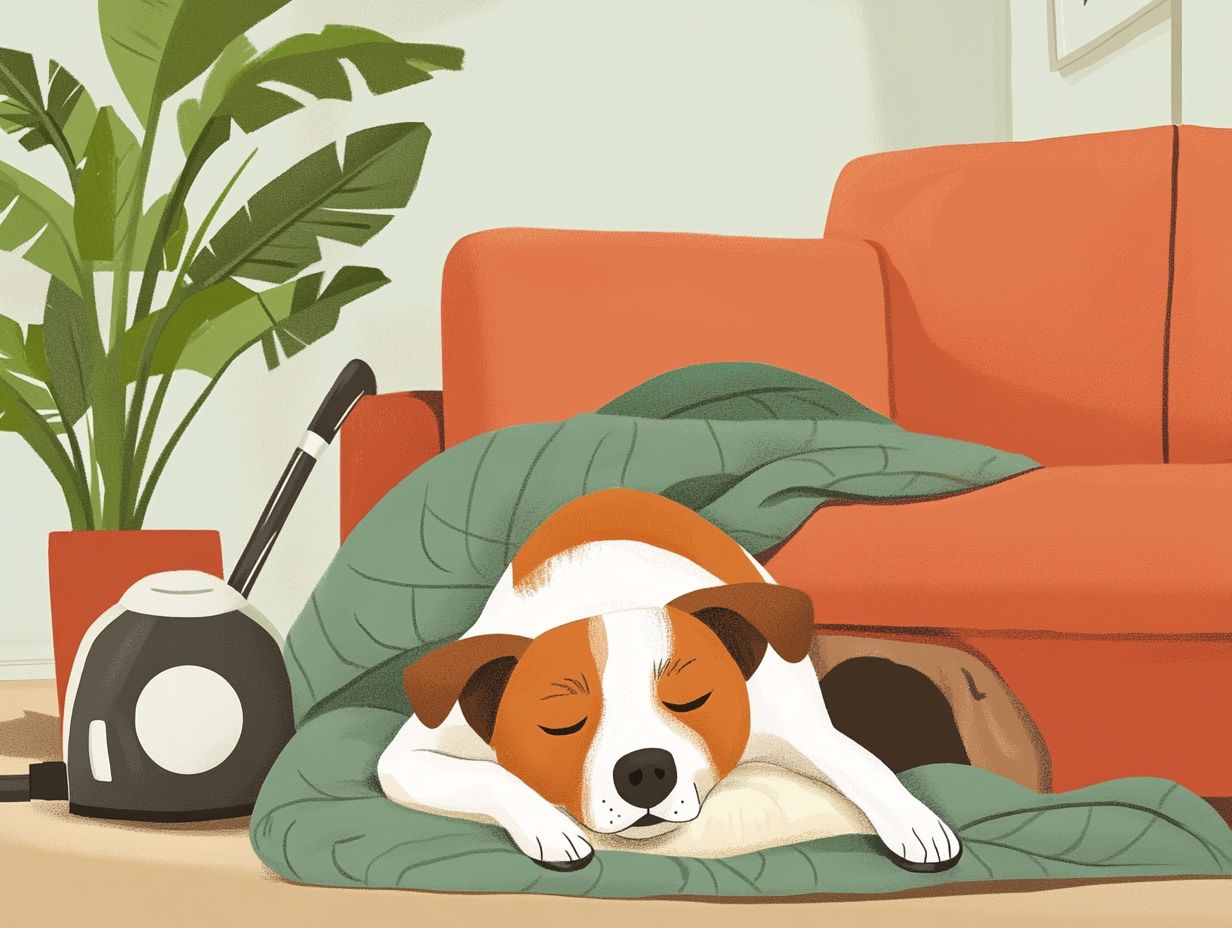The Impact of Household Items on Pet Anxiety
Pet anxiety is a growing concern for many pet owners. Your furry companions can experience stress just like you do.
Understanding the causes and symptoms of this anxiety is vital for creating a harmonious home environment. This is especially true for dog owners who want to ensure their pets’ well-being. Everyday factors, such as sudden loud noises and changes in routine, can trigger distress in your pets.
This article explores effective strategies to alleviate anxiety. You ll learn about creating calming spaces and using training methods that change how your pet behaves. It also looks at other options like natural supplements and professional training.
Act now to help your pet feel safe and secure in your home. Together, you can foster a tranquil atmosphere while managing their anxiety triggers.
Contents
Key Takeaways:

- Pet anxiety is common and can be triggered by household items like loud noises, changes in routine, and separation from the owner.
- Creating a calming environment and using training methods can help reduce pet anxiety and improve overall well-being.
- Natural supplements and professional training can also effectively manage pet anxiety and promote a stress-free household.
Understanding Pet Anxiety
Understanding pet anxiety is essential for dog owners committed to the well-being of their furry companions. Canine anxiety can show itself in various ways, often triggered by everyday sounds or shifts in routine.
This emotional distress can lead to stress behaviors like barking, whining, or destructive actions, often driven by noise sensitivity or specific triggers.
Experts in veterinary science and animal behavior, such as Dr. Emma K. Grigg from the University of California, Davis, emphasize the importance of effective anxiety management strategies. Implementing these strategies can alleviate your dog’s anxiety and help you foster a healthier, more harmonious relationship with your pet.
Causes and Symptoms
The causes and symptoms of pet anxiety can vary significantly. They often arise from specific triggers linked to your dog’s environment or past experiences.
Common signs include excessive barking, hiding, or destructive behavior clear indicators of emotional distress, especially in dogs with separation anxiety.
This anxiety often roots from complex triggers. Loud noises, like thunderstorms or fireworks, can be particularly upsetting. A sudden change in routine, such as a family member leaving or moving to a new home, can amplify feelings of insecurity.
As a pet owner, you might notice signs like panting, pacing, or inappropriate elimination. Recognizing these symptoms is crucial for timely intervention, allowing you to offer comfort and reassurance. This may involve consultative training or behavior modification techniques tailored to help your furry companion find peace.
Common Household Items that Can Trigger Pet Anxiety
Many common household items can trigger pet anxiety, impacting your dog’s overall well-being and behavior. Understanding the influence of environment on pet anxiety can help you create a more soothing space for your furry friend.
Noises from loud appliances, vacuum cleaners, and even high-frequency sounds like smoke alarms can provoke noise sensitivity in dogs, possibly leading to anxiety disorders.
Recognizing these triggers is essential for you as a pet owner. Insights from veterinary professionals and advice from a canine behaviorist can be invaluable in navigating this challenge.
Loud Noises
Loud noises are common triggers for canine anxiety. They often cause significant emotional distress for dogs.
Think about it: thunder, fireworks, and even the whir of household appliances can trigger fear responses. This leaves pet owners grappling with their furry friends’ anxiety management.
When those sudden, jarring sounds hit, many dogs may react in ways that can be quite distressing. You might see barking, hiding, or even destructive behavior.
This can create stress for both the pet and the owner. It highlights the necessity for effective anxiety management strategies.
Techniques like slowly getting your dog used to the sounds that unsettle them can be helpful. Helping your dog associate those scary sounds with something positive is also beneficial.
Such strategies empower dogs to cope better with their fears. They also cultivate a more harmonious living environment for everyone involved.
Changes in Routine

Changes in routine can be significant anxiety triggers for dogs. These changes can lead to emotional distress and behavioral issues for you as a pet owner.
Dogs thrive on consistency. Any disruption in their daily activities can spark anxiety, especially for those prone to separation anxiety.
For example, moving to a new home can expose your pet to unfamiliar environments, scents, and sounds. This experience can be quite overwhelming.
Adjustments in your schedule, whether it s new work hours or travel plans, can mean less bonding and playtime. This further contributes to their sense of instability.
Establish a consistent schedule to make your dog feel safe and secure during transitions! Include regular feeding times, walks, and play sessions.
Implement gradual changes, like slowly introducing new environments or adjusting your schedule. This helps your dog adapt more comfortably.
Offering plenty of reassurance and maintaining a calm demeanor can create a secure atmosphere. This allows your furry friend to navigate these shifts with greater ease.
Separation from Owner
Separation from you, the owner, plays a crucial role in pet anxiety. It often surfaces as separation anxiety, leading to various stress behaviors in dogs.
<pYou might notice destructive actions or vocalizations when you leave them alone. This can lead to emotional distress for dogs, particularly those that have formed a close bond with you.
The severity of these symptoms can range from mild to severe. Some dogs may display excessive barking, whining, or even try to escape.
This anxiety can impact their health and strain your relationship with them. Addressing these issues is important.
Consider gradually increasing the time you spend away in a controlled manner. This can help with desensitization.
Incorporating calming products can also help. Items like anxiety wraps or pheromone diffusers can create a more comforting atmosphere, especially when you learn about understanding anxiety triggers in pets.
These products allow your dog to feel secure even in your absence.
Ways to Reduce Pet Anxiety
Act now to reduce your pet s anxiety! It’s crucial for their happiness and your peace of mind.
Reducing your pet’s anxiety demands a thoughtful, multifaceted approach. This may include creating a calming environment and implementing behavior modification techniques.
By seeking the expertise of a canine behaviorist or consulting with veterinary professionals, you can develop customized solutions. These solutions specifically address and alleviate the stress behaviors displayed by anxious dogs.
Creating a Calming Environment
Creating a calming environment for your pets eases their anxiety, which is especially important for those with noise sensitivity. Understanding the impact of separation anxiety on pets can further help in providing the right support.
Simple adjustments, like creating quiet spaces and using calming aids, can greatly enhance your pet’s well-being. For instance, implementing the top 10 environmental adjustments for anxious pets can help your furry friends feel more comfortable.
Incorporate soundproofing measures, like heavy curtains, to muffle outside noises. Create a cozy corner with soft bedding and familiar toys for your pets to retreat to when they feel overwhelmed.
Regular playtime and gentle exercise are key in reducing anxiety triggers. Consider using calming essential oils or pheromone diffusers to help foster relaxation.
By thoughtfully making these changes, you can create a nurturing atmosphere today. Help your furry companions thrive!
Behavior Modification Techniques
Behavior modification techniques are invaluable for managing anxiety in your pets, especially in addressing stress behaviors linked to dog anxiety.
By collaborating with a dog trainer and tapping into insights from veterinary science, you can equip yourself with effective strategies tailored specifically to your dog’s needs.
These methods include various approaches, such as gradual exposure. This technique allows your dog to be gradually exposed to anxiety-inducing stimuli in a controlled manner, helping them learn to cope more effectively.
Counter-conditioning can also be beneficial; it alters your dog s emotional response to stressful situations by pairing them with positive experiences, like treats or playtime.
Implementing positive reinforcement encourages desired behaviors, rewarding your pet for remaining calm during anxiety-provoking scenarios. Be patient and consistent, as gradual progress may take time. However, this investment can lead to a more relaxed and happy dog.
Alternative Options for Managing Pet Anxiety

Exploring alternative options for managing your pet’s anxiety equips you with valuable tools to support your canine companion.
From natural supplements to professional training services, these resources seamlessly complement traditional anxiety management strategies and behavioral approaches grounded in veterinary science.
Natural Supplements
Natural supplements can significantly support anxiety management in dogs, helping to ease the emotional turmoil that often accompanies canine anxiety.
These supplements, frequently endorsed by veterinary science, provide pet owners with valuable tools to enhance their dog’s relaxation and calmness.
Among the most favored options are herbal remedies like valerian root and chamomile, renowned for their soothing properties. You might also consider omega-3 fatty acids, which play a vital role in promoting optimal brain function and emotional well-being in dogs susceptible to anxiety disorders.
L-theanine, an amino acid known for fostering relaxation without causing sedation, is another excellent choice.
While these natural remedies can be effective, remain vigilant about potential risks, such as interactions with other medications or allergies. Consulting with a veterinary medicine professional before introducing any new supplement is crucial. This ensures a safe and effective treatment plan tailored specifically to your dog’s needs.
Professional Training
Professional training services, often led by a skilled dog trainer, can greatly enhance your journey in managing your dog’s behavior and anxiety. This specialized training focuses on identifying specific anxiety triggers and equips you with essential skills to support your furry friend.
In these sessions, expect a personalized approach as the trainer assesses your dog’s unique situation. This tailored program not only provides practical techniques for home but also fosters a collaborative environment where you and your dog learn to communicate effectively.
Over time, these strategies lead to lasting improvements, reducing anxiety-driven reactions. By investing in guidance from a dog trainer, you pave the way for a harmonious living environment that enriches both your life and your dog’s.
Frequently Asked Questions
What household items can cause anxiety in pets?
Common household items that can trigger anxiety in dogs include loud appliances like vacuum cleaners and blenders. Strong odors from cleaning products, perfumes, and unfamiliar objects can also create stress, but understanding the role of space in reducing pet anxiety can help alleviate some of these issues.
How can I tell if my pet is anxious?

Signs of anxiety in dogs include pacing, panting, hiding, excessive barking, destructive behavior, and changes in appetite or bathroom habits. If you notice these signs, something in your home may be causing your pet’s anxiety.
Can household items help reduce pet anxiety?
Yes! Certain household items can help calm pets. Calming pheromone sprays, soft music, or white noise machines can be beneficial, as can games to alleviate pet anxiety that keep your pet mentally stimulated.
How can I create a pet-friendly home?
To make your home pet-friendly, remove potential stressors related to noise. Keep loud appliances in a separate room, use pet-safe cleaning products, and consider tips for reducing clutter to calm pets while introducing new items slowly.
What should I do if my pet is anxious due to a household item?
If a household item is causing anxiety, address it quickly. This may mean removing the item, providing your pet with a safe space, and consulting a vet or animal behaviorist if anxiety persists. Understanding the impact of shelter life on pet anxiety can also be helpful in these situations.
Are there alternative treatments for pet anxiety?
Yes, there are alternatives like natural supplements, acupuncture, and behavioral therapy. Always consult with your veterinarian before trying any new treatment to ensure it s safe for your pet.






